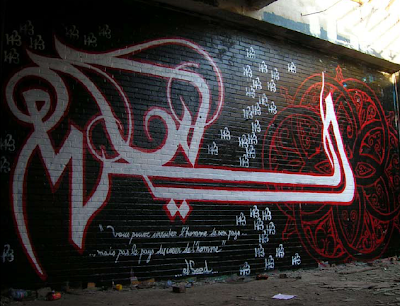Building bridges across communities, cultures, preconceptions and artistic forms, El Seed is throwing up a unifying mirror of colour, clean form and the universality of cross cultural humanty. Fusing the ancient medium of calligraphy with the urban poetry of graffiti and street art, he unites two artistic currents into Calligraffiti, both in an exploration of his own conflicted identity of a Muslim living in an often dangerously prejudiced western world and the nature of that prejudice itself as he opens a dialogue across religion, culture and community through the glorious metaphor of stylistic heterodoxy. We contacted El Seed as he painted the street of Montreal a softer shade of understanding and had a conversation.
Can you tell us a little about your background
I grew up in Paris, France. The son of Tunisian immigrants, I was raised between two worlds; between my North African roots and my French European education. I have always been interested in combining these two aspects of my identity, in both my art and in other ventures. I started painting and drawing when I was quite young, but never had any formal training as I ended up in business school.
What took you down the road to Calligraffiti?
Ever since I began to paint and make art, calligraphy was a big part of my life and I would draw inspiration from the old masters of calligraphy. Graffiti also came early on in my artistic life. I began to tag the walls of Paris in 1998 but stopped shortly after my focus changed to University studies. However, I continued to paint on clothes with styles reminiscent of the graffiti and street art scene, never quite losing touch with hip hop culture. Once I moved to North America, first New York City, then Montreal, I began to paint again with the graffiti artist Hest. Through his guidance and support, I began to mix my love for calligraphy and graffiti and eventually emerged with my own style. I am definitely not the first nor the last to paint walls using Arabic script, but my own particular style grew from a mix of classical calligraphy, using clean edges and complicated lettering, and old school graffiti, using walls to create messages and get people to think about pertinent issues.
Can you give us some insight into why calligraphy is considered the highest form of art within Islam
From what I understand, calligraphy developed as a profoundly Islamic form of art due to restrictions concerning pictorial representations, which have their roots in hadiths. Certain schools of thought posit that reproducing images of living creatures is prohibited within Islam, therefore developing forms of art which avoided direct representations of living beings. Furthermore, reverence for the divine text, the Qur’an, gave words and writing a high rank in Islamic societies. Historically, scribes were commissioned to reproduce the Qur’an in the most beautiful lettering possible, thus encouraging artists to develop highly stylized forms of writing. It seems to me that the combination of love and reverence for the Qur’an and certain revelations said to prohibit reproducing living things have made calligraphy one of the most distinct and highest forms of art within Islamic cultures.
How does Islam impact your creative process?
As a Muslim, Islam impacts every part of my life, including my art. Early on, I would paint portraits, cartoons and other forms of representational art. However, as my knowledge of Islam grew and I began to integrate its principles into my everyday life, I realized that I no longer wanted to represent living beings. This is the main reason why I began to develop calligraphy into my painting and why it has now become the vehicle for my artistic messages. In this sense, Islam has shaped my creative process and has guided my paintbrush and my spray can to where they now point.
The name El Seed – is that a play on Sa’id or El Cid, or does it refer to the idea of planting a seed of thought?
When I started graffiti in 1998, I was looking for a name with an Arabic sound which would correspond with my North African roots. I was first inspired by the book ‘Le Cid’ by the French author Corneille. Cid, or Sa’id, means ‘the Man’ and this appealed to me in my youth so I began to tag my name as ‘El Scid’. However, as I began to develop my calligraphic style and my artistic vision began to mature, I changed my name to ‘eL Seed’. I found that this spelling better reflected the quest for my roots and my origins by calling upon the metaphor of a plant.
Do you intend people to decipher the word, as in give it a sound, or view it only visually?
Since I produce murals with the intention of them being viewed in both Arabic and non- Arabic speaking parts of the world, I strive to deliver art which is both pleasing to the eye and thoughtful in its meaning. The writing itself is always important, and every word or phrase I choose is pregnant with allegorical and interpretive meaning. I try to use eyecatching forms and arrangements to pull the viewer into the piece and essentially awaken a curiosity as to what it all means. At the end of the day, one of my main aims is to make people who don’t understand Arabic want to understand, and thus create bridges between languages, cultures and paradigms.
What does abstraction of the written word bring to its meaning?
Being able to appreciate the form of a letter or a word enables the viewer to perceive language not just as letters, words, and sentences but also as art and poetry. Abstraction of the written word provides a more holistic vision and appreciation of what is being read. A letter or word thus begets a personality, a form, an image, which complements its meaning.
READ FULL INTERVIEW IN LSD MAGAZINE ISSUE FIVE








No comments:
Post a Comment